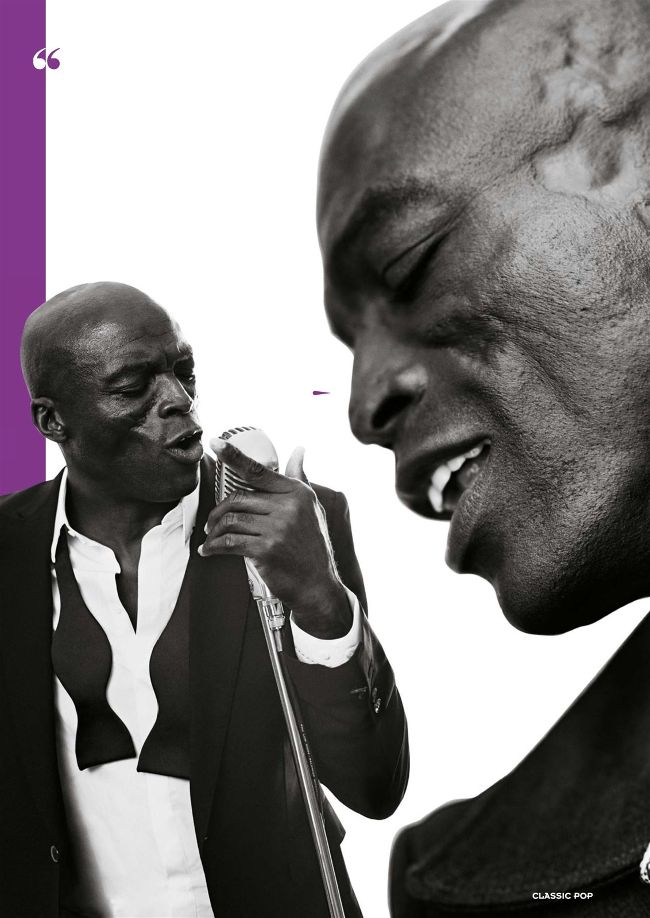" WHEREVER IT IS WE GO TO IN THE ETHER, I’LL LOOK BACK WITH ZERO REGRETS
A BEAUTIFUL SINGER WITH THE LOOKS TO MATCH, SEAL ALWAYS SEEMED DESTINED FOR STARDOM. BUT A NEW REISSUE OF HIS SELF-TITLED DEBUT ALBUM IS TIME TO REMEMBER THAT STARDOM ONCE SEEMED LIGHT YEARS AWAY FOR ONE OF THE FINEST VOCALISTS BRITAIN HAS PRODUCED. IN A RARE INTERVIEW, SEAL RECALLS HOW THE STAGE USED TO TERRIFY HIM, WHILE TREVOR HORN REVEALS THEIR UNLIKELY BONDING INFLUENCES. “IT’S BEEN A HELL OF A RUN,” AS SEAL TELLS CLASSIC POP.
JOHN EARLS
Seal is a huge presence. The first time I met him, he had Cuban heel boots on, when he’s 6ft 5ins anyway.” So says Trevor Horn of his initial encounter with Sealhenry Samuel at the producer’s famed London recording studio, Sarm West.
That Seal sought to make himself even bigger than he was already is appropriate for a singer whose music has always been more grandiose and replete with memorable moments than such a classy vocalist needed to get by. Where lesser talents seek to show off with vocal gymnastics, Seal knows that the song is the star.
Still, Seal’s longtime producer is right: Seal is a huge presence. Over Zoom from his home studio in L.A., the singer is relaxed for someone who rarely talks to the British press. He’s unguarded, funny and likes a dramatic gesture into his laptop camera. He’s every bit as Seal as you’d hope, aware of his role in music.
“In people’s eyes, I’m a singer,” he notes reasonably. “Nobody wants to hear my political views. If people listen to Seal, it’s because they want relief. They don’t want me banging on about whatever. Therefore, my job is really simple: come up with good songs. Hopefully one or two great ones. It’s really that straightforward. It’s not like we’re performing open-heart surgery or saving lives.” Seal has provided relief and a chance to shimmy ever since Killer with Adamski crashed to No.1 in 1990. An early example of a featured vocalist, the unknown Seal was an instant star. As Trevor explains: “You can tell when the public is interested in someone. Buying a single, you’re just interested in the record itself. Buying an album? You have to be interested in the artist to buy their album, and I could tell the public were interested in Seal.”

Seal: “My job is really simple: come up with good songs. Hopefully one or two great ones.”
For all his obvious charisma, Seal was 27 when Killer got the public’s attention. In pop years, the Londoner was middle-aged to be introduced to the nation. Frankly, Seal, what kept you? “That’s what I used to think,” he laughs. “Finding your voice, that’s the path of every artist. Before Killer, I wrote a bunch of songs I thought were great. On reflection, they were shite.”
Like a musical Doctor Who, Seal had tried a bunch of incarnations – most notably funk band Push – before finding his first niche in rave. “I thought it was clear where I was going,” he admits. “But, when people came to see me play, they said the same thing: ‘He’s got an interesting voice, but what is he? If he’s rock, how come he’s black? Why isn’t he doing R&B or reggae?’ They weren’t interested. I thought they were all deaf, and my attitude was: ‘What’s wrong with you?’ The industry just didn’t know how to market me. Then someone gave me a cassette, and one play of that made me go: ‘Ohhhh! Now I see why it’s not happening.’”
The friend’s cassette featured Joni Mitchell, Led Zeppelin, Jimi Hendrix and Crosby, Stills & Nash. “I didn’t write a lick of music for a year, so I could soak up everything by these incredible musicians,” Seal reflects.
Leggete l'articolo completo e molti altri in questo numero di
Classic Pop
Opzioni di acquisto di seguito
Se il problema è vostro,
Accesso
per leggere subito l'articolo completo.
Singolo numero digitale
Jan/Feb 2023
Questo numero e altri numeri arretrati non sono inclusi in un nuovo
abbonamento. Gli abbonamenti comprendono l'ultimo numero regolare e i nuovi numeri pubblicati durante l'abbonamento.
Classic Pop
Abbonamento digitale annuale
€51,99
fatturati annualmente